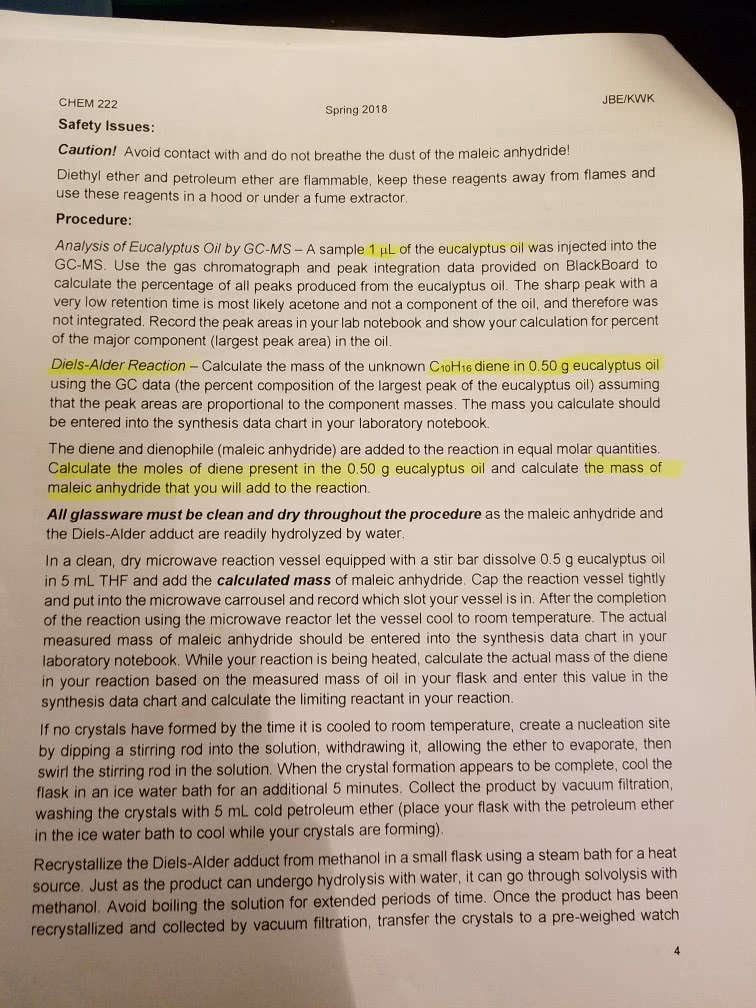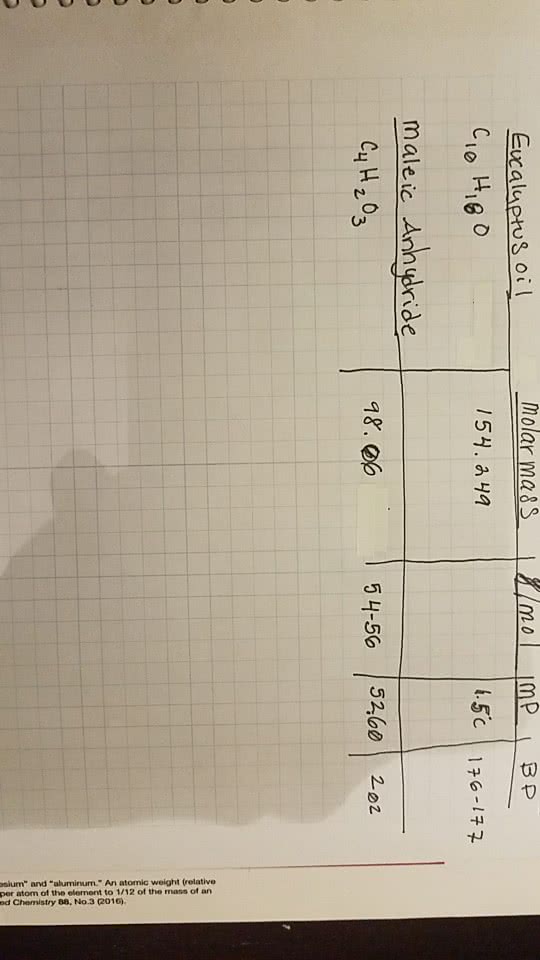A note of caution concerning the GC data software: This software produces a tabulated summary of the peak retention times, peak areas, and peak area percentages for each chromatogram. Those percentages are not unique to any specific compounds, but rather they are expressed as fractions of the sum of all detected peak areas. For the calculations necessary to this exercise, new peak area percentages will need to be calculated for only the oxygenates peaks in your chromatograms and your calculations based upon those new percentages.
Two tables of GC peaks, identified by their associated gasoline component(-s), are presented below. Table 1 gives the results of an analysis of a gasoline mix without any âspikeâ (a âspikeâ is an addition of a known quantity of an analyte to a sample). Table 2 shows a GC analysis of the same gasoline mixture following the addition of 75 μL of pure methanol to a 1000 uL sample of the gasoline. Note two differences between the chromatogram peak areas; the methanol area increased from the spike (expected), and the other peak areas diminished.
Complete Table 3 by calculating the volume percentages of the six oxygenates in the 1000 μL of the original, unspiked gasoline sample from the observed changes in their peak areas following the methanol spike. To begin this calculation you will need to calculate the methanol GC response factor (μL / area count). Report this response factor in the indicated space on page 2. Report the original volumes of the oxygenates in the original, unspiked gasoline sample, and then report the oxygenatesâ original concentrations as percentages of the whole unspiked 1000 μL gasoline sample.
Table 1: Unspiked Gasoline
Component
Area
Counts
Area %
Pentane
236000
22.8404
Methanol
57
0.0055
Hexane
312100
30.2055
Ethanol
3200
0.3097
Isopropanol
563
0.0545
Cyclohexane
180111
17.4314
n-Butanol
2000
0.1936
di-n-Butyl Ether
360
0.0348
Benzene
73000
7.0650
Heptane
35001
3.3874
Isooctane
110111
10.6567
n-Pentanol
5100
0.4936
Toluene
6732
0.6515
Ethylbenzene
53211
5.1498
m- and p-Xylenes
11011
1.0657
o-Xylene
4700
0.4549
Totals
721603
100
Table 2: Methanol-Spiked Gasoline
Component
Area
Counts
Area %
Pentane
219535
21.2469
Methanol
783
0.0758
Hexane
290326
28.0981
Ethanol
2977
0.2881
Isopropanol
524
0.0507
Cyclohexane
167545
16.2152
n-Butanol
1860
0.1801
di-n-Butyl Ether
335
0.0324
Benzene
67907
6.5721
Heptane
32559
3.1511
Isooctane
102429
9.9132
n-Pentanol
4744
0.4591
Toluene
6262
0.6061
Ethylbenzene
49499
4.7905
m- and p-Xylenes
10243
0.9913
o-Xylene
4372
0.4231
Totals
671989
100
Table 3: Gasoline Oxygenates Assay
Component
Volume
(μL)
Volume
Percentage
Methanol
Ethanol
Isopropanol
n-Butanol
di-n-Butyl Ether
n-Pentanol
Methanol GC Detector Response (μL/area count) = _______________
A note of caution concerning the GC data software: This software produces a tabulated summary of the peak retention times, peak areas, and peak area percentages for each chromatogram. Those percentages are not unique to any specific compounds, but rather they are expressed as fractions of the sum of all detected peak areas. For the calculations necessary to this exercise, new peak area percentages will need to be calculated for only the oxygenates peaks in your chromatograms and your calculations based upon those new percentages.
Two tables of GC peaks, identified by their associated gasoline component(-s), are presented below. Table 1 gives the results of an analysis of a gasoline mix without any âspikeâ (a âspikeâ is an addition of a known quantity of an analyte to a sample). Table 2 shows a GC analysis of the same gasoline mixture following the addition of 75 μL of pure methanol to a 1000 uL sample of the gasoline. Note two differences between the chromatogram peak areas; the methanol area increased from the spike (expected), and the other peak areas diminished.
Complete Table 3 by calculating the volume percentages of the six oxygenates in the 1000 μL of the original, unspiked gasoline sample from the observed changes in their peak areas following the methanol spike. To begin this calculation you will need to calculate the methanol GC response factor (μL / area count). Report this response factor in the indicated space on page 2. Report the original volumes of the oxygenates in the original, unspiked gasoline sample, and then report the oxygenatesâ original concentrations as percentages of the whole unspiked 1000 μL gasoline sample.
| Table 1: Unspiked Gasoline | ||
| Component | Area Counts | Area % |
| Pentane | 236000 | 22.8404 |
| Methanol | 57 | 0.0055 |
| Hexane | 312100 | 30.2055 |
| Ethanol | 3200 | 0.3097 |
| Isopropanol | 563 | 0.0545 |
| Cyclohexane | 180111 | 17.4314 |
| n-Butanol | 2000 | 0.1936 |
| di-n-Butyl Ether | 360 | 0.0348 |
| Benzene | 73000 | 7.0650 |
| Heptane | 35001 | 3.3874 |
| Isooctane | 110111 | 10.6567 |
| n-Pentanol | 5100 | 0.4936 |
| Toluene | 6732 | 0.6515 |
| Ethylbenzene | 53211 | 5.1498 |
| m- and p-Xylenes | 11011 | 1.0657 |
| o-Xylene | 4700 | 0.4549 |
| Totals | 721603 | 100 |
| Table 2: Methanol-Spiked Gasoline | ||
| Component | Area Counts | Area % |
| Pentane | 219535 | 21.2469 |
| Methanol | 783 | 0.0758 |
| Hexane | 290326 | 28.0981 |
| Ethanol | 2977 | 0.2881 |
| Isopropanol | 524 | 0.0507 |
| Cyclohexane | 167545 | 16.2152 |
| n-Butanol | 1860 | 0.1801 |
| di-n-Butyl Ether | 335 | 0.0324 |
| Benzene | 67907 | 6.5721 |
| Heptane | 32559 | 3.1511 |
| Isooctane | 102429 | 9.9132 |
| n-Pentanol | 4744 | 0.4591 |
| Toluene | 6262 | 0.6061 |
| Ethylbenzene | 49499 | 4.7905 |
| m- and p-Xylenes | 10243 | 0.9913 |
| o-Xylene | 4372 | 0.4231 |
| Totals | 671989 | 100 |
| Table 3: Gasoline Oxygenates Assay | ||
| Component | Volume (μL) | Volume Percentage |
| Methanol | ||
| Ethanol | ||
| Isopropanol | ||
| n-Butanol | ||
| di-n-Butyl Ether | ||
| n-Pentanol | ||
Methanol GC Detector Response (μL/area count) = _______________


